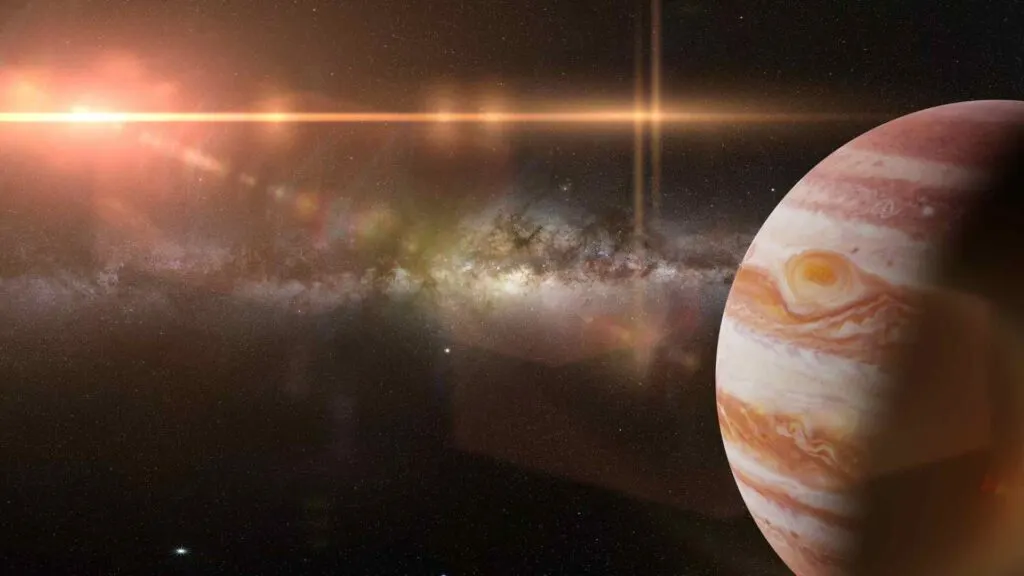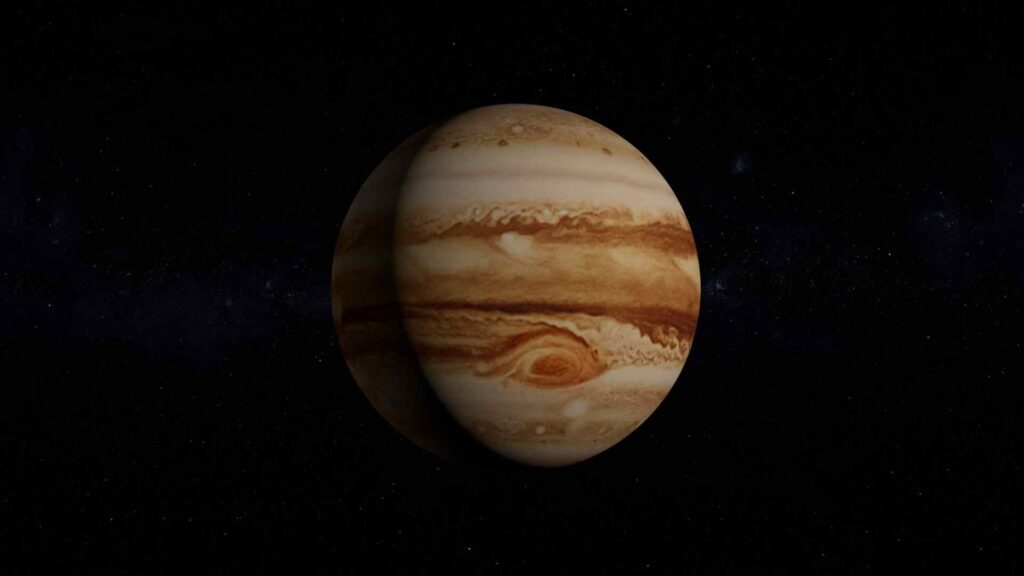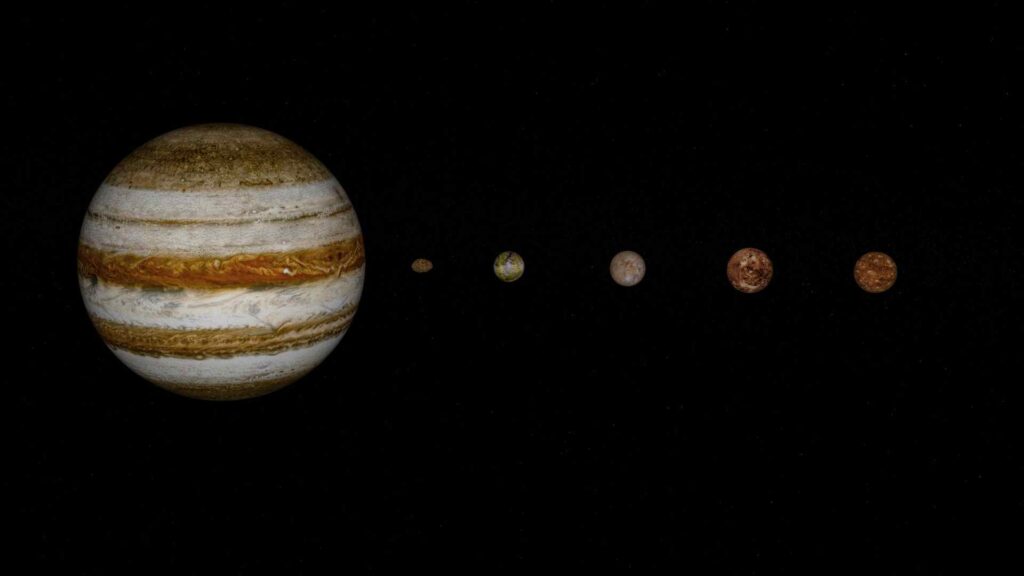Jupiter, the giant of our solar system, holds countless mysteries and jaw-dropping phenomena.
From its colossal storms to its many intriguing moons, there’s so much to learn about this incredible planet. Dive into these 145 fun facts about Jupiter to explore its wonders and uncover its secrets!
Jupiter’s Physical Characteristics
- Jupiter is the largest planet in our solar system, with a diameter of 142,984 kilometers.
- Its mass is more than 318 times that of Earth, making it a true giant among planets.
- Jupiter has a surface area of 6.14 x 10^10 km², roughly 120 times Earth’s surface area.
- This planet is a gas giant primarily composed of hydrogen and helium.
- Jupiter’s density is only about 1.33 grams per cubic centimeter—lower than any rocky planet.
- It has no solid surface, making landing on Jupiter nearly impossible.
- The planet’s immense size means it has an incredibly strong gravitational field.
- It’s the fourth-brightest object in the sky, following the Sun, Moon, and Venus.
- Jupiter’s fast rotation causes it to bulge at the equator, giving it an oblate shape.
- Jupiter is about 5.2 astronomical units (AU) from the Sun, much farther than Earth.
- The gas giant completes a full rotation in under 10 hours, the fastest of all planets.
- Its strong magnetic field is 14 times stronger than Earth’s, extending far into space.
- The temperature at Jupiter’s cloud tops is a chilly -145 degrees Celsius (-234 degrees Fahrenheit).
- Jupiter has faint rings made up mainly of dust particles from its moons and debris.
- Its atmosphere consists of hydrogen, helium, methane, ammonia, and traces of water vapor.

The Great Red Spot and Jupiter’s Weather
- Jupiter’s Great Red Spot is a massive, persistent storm larger than Earth.
- This famous storm has existed for at least 400 years, though it may be much older.
- The Great Red Spot‘s winds can reach speeds of up to 432 km/h (268 mph).
- The storm appears red due to chemicals like phosphine and sulfur in the atmosphere.
- Recently, the Great Red Spot has been shrinking, puzzling scientists.
- Jupiter’s atmosphere experiences lightning that can be hundreds of times more powerful than Earth’s.
- The planet’s clouds are primarily made up of ammonia and ammonium hydrosulfide.
- Beneath the clouds lies a layer of liquid metallic hydrogen that generates Jupiter’s magnetic field.
- Jupiter’s storm systems include “hot spots” where lightning and intense rainfall occur.
- The planet has multiple smaller storms, often forming “string of pearls” patterns.
- Scientists believe there’s no “solid ground” to stop storms, so they persist for centuries.
- Winds in Jupiter’s atmosphere can exceed 1,000 km/h (620 mph), especially near the equator.
- The planet’s rapid rotation and thick atmosphere lead to extreme atmospheric pressures.
- Jupiter’s polar regions feature unique auroras caused by particles from its moons.
- Cyclones cluster near both poles, creating stunning “polygons” of storms on the planet’s surface.

Jupiter’s Moons and Their Mysteries
- Jupiter has at least 79 known moons, with four large ones called the Galilean moons.
- Io, Europa, Ganymede, and Callisto were discovered by Galileo in 1610.
- Ganymede is the largest moon in the solar system, even bigger than Mercury.
- Io is the most volcanically active body in our solar system.
- Europa is believed to have a subsurface ocean, making it a potential home for life.
- Callisto, covered in ancient craters, is considered one of the oldest celestial bodies.
- The four Galilean moons are visible with binoculars from Earth.
- Jupiter’s moons affect the planet’s magnetic field and even its ring system.
- Ganymede has its magnetic field, a unique trait for a moon.
- Europa’s ice-covered surface may hide a warm, salty ocean beneath.
- Io’s volcanoes are driven by tidal forces from Jupiter’s intense gravity.
- Some of Jupiter’s smaller moons, like Amalthea, are thought to be captured asteroids.
- Jupiter’s moon count continues to grow as astronomers discover smaller satellites.
- Callisto’s surface is scarred with impact craters, revealing its age and history.
- The gravitational interplay between Jupiter and its moons can create fascinating tidal effects.
Jupiter’s Ring System
- Unlike Saturn, Jupiter has faint rings made up of dust and tiny particles.
- The rings are divided into three sections: the halo, main, and gossamer rings.
- These rings were discovered by the Voyager 1 spacecraft in 1979.
- Jupiter’s rings are mostly composed of material from its moons.
- The halo ring is closest to the planet, thicker but less dense than others.
- The main ring is thin, mostly formed from dust created by moon impacts.
- The gossamer rings extend far out from Jupiter and are the faintest of all.
- The dust particles in the rings are so fine that they’re hard to detect without special equipment.
- Material in Jupiter’s rings is constantly replenished by collisions on its moons.
- The rings are brightest when viewed from behind with sunlight shining through.
- Jupiter’s gravity pulls in nearby particles, keeping the rings from dissipating into space.
- Unlike Saturn’s icy rings, Jupiter’s are primarily made of rocky material.
- Jupiter’s rings were the third ring system discovered in our solar system.
- They extend about 225,000 kilometers (140,000 miles) from Jupiter’s center.
- These rings are best observed in infrared light, revealing their delicate structure.

Space Missions to Jupiter
- Pioneer 10 was the first spacecraft to visit Jupiter in 1973, sending back the first close-up images.
- The Voyager 1 and Voyager 2 missions provided groundbreaking insights into Jupiter’s atmosphere.
- Galileo orbiter spent eight years studying Jupiter and its moons in the 1990s.
- NASA’s Juno mission, launched in 2011, continues to orbit and study Jupiter today.
- Juno has revealed new details about Jupiter’s magnetic field and atmospheric structure.
- Juno’s mission has been extended to study Jupiter’s poles and close flybys of its moons.
- Cassini flew by Jupiter on its way to Saturn, capturing valuable data.
- New Horizons provided fresh views of Jupiter en route to Pluto.
- Ulysses used Jupiter’s gravity to slingshot towards the Sun’s poles.
- The European Space Agency’s JUICE mission aims to study Jupiter’s icy moons in the 2030s.
- Juno’s stunning imagery of Jupiter’s polar cyclones was an unexpected discovery.
- Galileo discovered that Jupiter’s moon Europa has a salty ocean beneath its ice crust.
- Voyager missions revealed Jupiter’s thin rings and the intensity of its magnetic field.
- Juno’s microwave radiometer allows scientists to see beneath Jupiter’s thick clouds.
- NASA is considering future missions to study Europa and search for signs of life.
Jupiter’s Influence in the Solar System
- Jupiter’s gravity protects Earth by deflecting comets and asteroids.
- It acts as a “cosmic vacuum cleaner,” absorbing or redirecting debris.
- Without Jupiter, the asteroid belt might not exist in its current form.
- The planet’s immense gravitational pull affects the orbits of other celestial bodies.
- Jupiter’s gravity created “Trojan asteroids” that share its orbit around the Sun.
- The gas giant occasionally captures rogue asteroids and comets into temporary orbits.
- Its presence has helped shape the stability and structure of the solar system.
- Jupiter is thought to have migrated early in the solar system’s history, influencing other planets.
- It stabilizes the orbits of the inner planets, contributing to the solar system’s structure.
- Some scientists think Jupiter’s formation prevented a second Sun from forming in our system.
- Jupiter’s gravitational field has nudged comets into paths that intersect with Earth.
- It’s so massive that it affects the orbits of nearby objects even far beyond its orbit.
- Many objects in the asteroid belt are influenced by Jupiter’s strong gravitational force.
- Jupiter’s intense magnetic field affects particles in its magnetosphere, extending millions of miles.
- The gas giant’s gravity has created “resonances” that affect other planets and objects.
Bonus Facts About Jupiter
- Jupiter was named after the king of the Roman gods, Zeus’s counterpart in mythology.
- The ancient Babylonians were among the first to observe Jupiter around 7th century BCE.
- Jupiter has been a key object in both ancient and modern astronomy.
- The gas giant is visible with the naked eye and has been studied for millennia.
- Jupiter has auroras caused by particles interacting with its magnetic field.
- Scientists speculate that its core might be surrounded by a layer of metallic hydrogen.
- Jupiter’s magnetosphere is so large it stretches beyond Saturn’s orbit.
- The energy from Jupiter’s interior drives its weather systems.
- Galileo’s discovery of Jupiter’s moons helped support the heliocentric model of the solar system.
- It takes Jupiter about 12 Earth years to complete a single orbit around the Sun.
- Jupiter’s size means it exerts tremendous pressure on its interior layers.
- Its upper atmosphere is home to water clouds, but it’s not enough for rain like on Earth.
- Despite its size, Jupiter doesn’t produce heat from nuclear fusion like stars.
- Jupiter’s magnetic field traps high-energy particles, creating intense radiation.
- Its magnetosphere would appear larger than the full Moon if visible from Earth.
- Some of Jupiter’s smaller moons are less than a kilometer across.
- The gas giant has inspired countless stories and names in mythology and culture.
- Jupiter emits more radiation than it receives from the Sun due to its internal heat.
- Voyager 1 discovered Jupiter’s “lightning bolts” for the first time.
- Observing Jupiter’s clouds can reveal changes in its weather patterns.
- In 1994, fragments of the comet Shoemaker-Levy 9 crashed into Jupiter, leaving dark scars.
- Jupiter’s clouds are so thick that we can only see the uppermost layers.
- Scientists think Jupiter’s atmosphere might contain simple organic molecules.
- Jupiter was formed roughly 4.5 billion years ago, shortly after the Sun.
- The distance between Jupiter and Earth varies significantly due to their orbits.
- The planet’s gravity is so strong it bends light passing nearby.
- The Juno mission has shown Jupiter’s magnetic field is highly asymmetrical.
- Jupiter’s temperature varies from -145°C at the cloud tops to thousands of degrees in the core.
